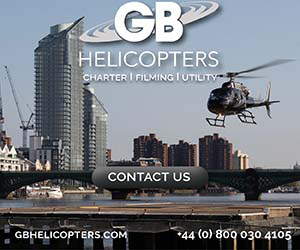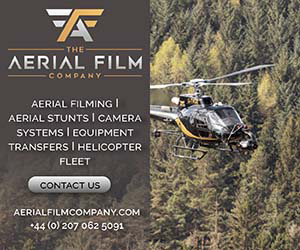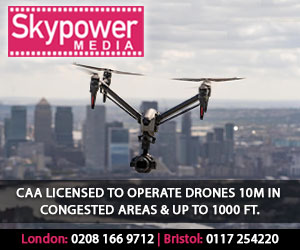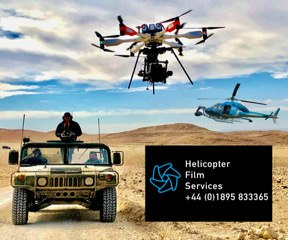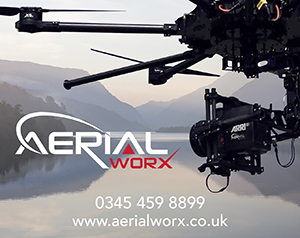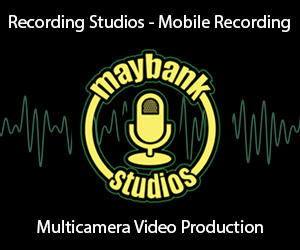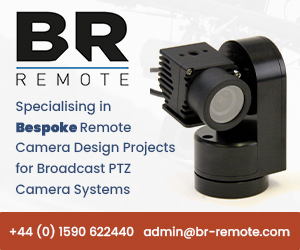Broadcast News
01/07/2015
Commercial UAV Operation In UK Airspace
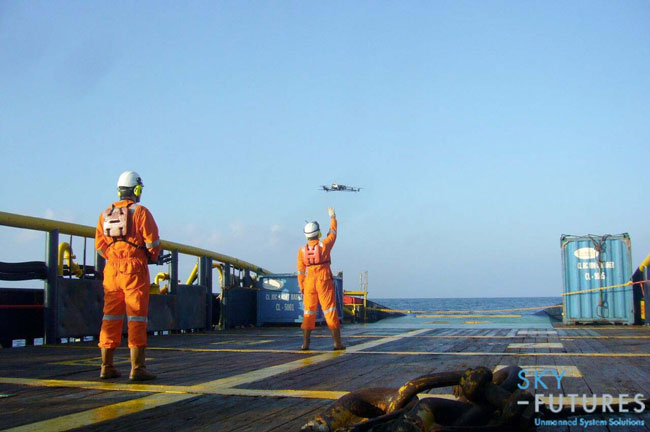
Sub-20kg Remote Piloted Aircraft Systems (RPAS) are the fastest growing aviation sector in the UK. The sector is expanding at an incredible rate but just what are the rules and regulations for the operation of 'drones' in UK airspace, and do General Aviation and Military Aviation have anything to fear from this proliferation? By ARPAS-UK.
Perception
It seems that rarely a week passes now without an article in the mainstream media regarding spectacular footage captured using small RPAS systems, illegal flight operation, or the potential for nefarious usage.
ARPAS-UK, the UK trade association, believes that users can be divided into three distinct groups:
• Consumers – who purchase small read to fly quad-rotors and operate them with little or no knowledge of rules and regulations. These can be with or without cameras.
• Hobbyists – who are aware of the rules and have many years radio controlled modelling experience. They are also insured for third party risk and generally confine their activities to dedicated sites.
• Commercial – users, many from a non-aviation background, who have either started a business predominantly to capitalise on the opportunities these systems bring to the table, or have integrated RPAS into an existing business.
In the UK, there are now over 550 commercial operators operating in industries such as TV and Film Production, Agriculture, Surveying and Inspection, using both multi-rotor and fixed wing systems. At a recent RPAS conference in London, the Civil Aviation Authority (CAA) confirmed another 90 permits were backlogged on the system, illustrating the phenomenal growth of the sector.
Rules and Regulations
Anybody operating an unmanned aircraft in the UK must abide by certain rules, including:
• Before each flight, check drone for damage
• Drone must be in sight at all times
• Stay well clear of airports and airfields
• Don't fly an unmanned aircraft within 50m of a person, vehicle or building
• Think about what you do with any images you obtain as you may breach privacy laws.
For commercial users, in order to fly a SUA (small unmanned aircraft) for commercial gain, the key requirement is to hold a Permission for Aerial Work (PfAW) from the CAA. In order to gain this, the CAA requires to see a completed operations manual and evidence of pilot competency which is broken into three elements; adequate theoretical knowledge/general airmanship, successful completion of a practical flight assessment on the class of SUA that is being applied for, and a minimum amount of recent flying experience on the class of SUA that is being applied for.
For those coming from a non-aviation background, in order to achieve this you would attend a course run by one of the National Qualified Entities (NQE).
The PfAW will allow an operator to fly within the confines of the Air Navigation Order. In most cases, to operate successfully commercially there is a need to be able to operate in congested areas. However, the CAA wishes to see a far greater emphasis on safety.
Enter the safety case. UAS – OSC.
This looks at not just improved operational procedures and safety management systems but also looks in depth at pilot competency and the safety of the aircraft. Unless an operator has evidence to prove they have prior experience or have a proven track record as a PfAW holder then getting a safety case approved could prove difficult. Finally, if the operator is coming from an aviation background then the process could be simplified, as they may not be required to attend ground school, however a flight test and operations manual will still be required.
Two key questions arise from this namely, how long does the process take and how much is it likely to cost? In terms of time it very much depends on how long it takes to write the operations manual and to what quality you write it. Whilst completion of the process may be quicker it would be sensible to allow a good six months to complete the process.
These accredited courses currently cost between £1,200 and £1,600 with a CAA processing fee of £133 or £226, depending on whether the UAV is sub 7kg or 7-20kg, respectively. Finally, there is annual training renewal fee of around £90-125, although this is now voluntary. While this may seem expensive for some, the alternative of being caught an unlicensed RPAS for paid work could mean a hefty fine and a maximum up to two years in prison.
Enter ARPAS-UK
The Association of Remotely Piloted Aircraft Systems UK (ARPAS-UK) is a non-profit association, formed in 2013, to represent the RPAS industry in the UK and to help promote best practice amongst its members.
Since its inception, ARPAS-UK has grown to represent the majority of those operating in the commercial UAS industry, across all sectors. Through the hard work of our committee we have developed safety partnerships with the CAA and NATS. We also have working relationships with key stakeholders including BMFA, BALPA, KTN, ACPO, RAeS, and many others, where we actively champion greater co-operation with the membership.
As a direct result of ARPAS-UK liaison with the CAA, the UAS-OSC was created.
Summary
Commercial operators generally accept that they are stakeholders and ambassadors for the industry and that they have a responsibility to conduct their operation safely and professionally. ARPAS-UK do not see themselves as a Police force but instead look to educate and engage with key stakeholders to promote safe operation. ARPAS-UK are currently engaging with the Association of Chief Police Officers drone lead to this end. ARPAS-UK are also engaging with manufacturers as ultimately the problem of consumer level equipment straying into manned aviation airspace can be solved with software geo fencing and height restrictions.
www.arpas.uk
Perception
It seems that rarely a week passes now without an article in the mainstream media regarding spectacular footage captured using small RPAS systems, illegal flight operation, or the potential for nefarious usage.
ARPAS-UK, the UK trade association, believes that users can be divided into three distinct groups:
• Consumers – who purchase small read to fly quad-rotors and operate them with little or no knowledge of rules and regulations. These can be with or without cameras.
• Hobbyists – who are aware of the rules and have many years radio controlled modelling experience. They are also insured for third party risk and generally confine their activities to dedicated sites.
• Commercial – users, many from a non-aviation background, who have either started a business predominantly to capitalise on the opportunities these systems bring to the table, or have integrated RPAS into an existing business.
In the UK, there are now over 550 commercial operators operating in industries such as TV and Film Production, Agriculture, Surveying and Inspection, using both multi-rotor and fixed wing systems. At a recent RPAS conference in London, the Civil Aviation Authority (CAA) confirmed another 90 permits were backlogged on the system, illustrating the phenomenal growth of the sector.
Rules and Regulations
Anybody operating an unmanned aircraft in the UK must abide by certain rules, including:
• Before each flight, check drone for damage
• Drone must be in sight at all times
• Stay well clear of airports and airfields
• Don't fly an unmanned aircraft within 50m of a person, vehicle or building
• Think about what you do with any images you obtain as you may breach privacy laws.
For commercial users, in order to fly a SUA (small unmanned aircraft) for commercial gain, the key requirement is to hold a Permission for Aerial Work (PfAW) from the CAA. In order to gain this, the CAA requires to see a completed operations manual and evidence of pilot competency which is broken into three elements; adequate theoretical knowledge/general airmanship, successful completion of a practical flight assessment on the class of SUA that is being applied for, and a minimum amount of recent flying experience on the class of SUA that is being applied for.
For those coming from a non-aviation background, in order to achieve this you would attend a course run by one of the National Qualified Entities (NQE).
The PfAW will allow an operator to fly within the confines of the Air Navigation Order. In most cases, to operate successfully commercially there is a need to be able to operate in congested areas. However, the CAA wishes to see a far greater emphasis on safety.
Enter the safety case. UAS – OSC.
This looks at not just improved operational procedures and safety management systems but also looks in depth at pilot competency and the safety of the aircraft. Unless an operator has evidence to prove they have prior experience or have a proven track record as a PfAW holder then getting a safety case approved could prove difficult. Finally, if the operator is coming from an aviation background then the process could be simplified, as they may not be required to attend ground school, however a flight test and operations manual will still be required.
Two key questions arise from this namely, how long does the process take and how much is it likely to cost? In terms of time it very much depends on how long it takes to write the operations manual and to what quality you write it. Whilst completion of the process may be quicker it would be sensible to allow a good six months to complete the process.
These accredited courses currently cost between £1,200 and £1,600 with a CAA processing fee of £133 or £226, depending on whether the UAV is sub 7kg or 7-20kg, respectively. Finally, there is annual training renewal fee of around £90-125, although this is now voluntary. While this may seem expensive for some, the alternative of being caught an unlicensed RPAS for paid work could mean a hefty fine and a maximum up to two years in prison.
Enter ARPAS-UK
The Association of Remotely Piloted Aircraft Systems UK (ARPAS-UK) is a non-profit association, formed in 2013, to represent the RPAS industry in the UK and to help promote best practice amongst its members.
Since its inception, ARPAS-UK has grown to represent the majority of those operating in the commercial UAS industry, across all sectors. Through the hard work of our committee we have developed safety partnerships with the CAA and NATS. We also have working relationships with key stakeholders including BMFA, BALPA, KTN, ACPO, RAeS, and many others, where we actively champion greater co-operation with the membership.
As a direct result of ARPAS-UK liaison with the CAA, the UAS-OSC was created.
Summary
Commercial operators generally accept that they are stakeholders and ambassadors for the industry and that they have a responsibility to conduct their operation safely and professionally. ARPAS-UK do not see themselves as a Police force but instead look to educate and engage with key stakeholders to promote safe operation. ARPAS-UK are currently engaging with the Association of Chief Police Officers drone lead to this end. ARPAS-UK are also engaging with manufacturers as ultimately the problem of consumer level equipment straying into manned aviation airspace can be solved with software geo fencing and height restrictions.
www.arpas.uk
More Aerial Filming Stories
31/01/2023
Flying Features Relies On LiveU
For the third year in a row, the Santos Tour Down Under cycling race was broadcast live from the sky by Australian aerial filming company Flying Featu
Flying Features Relies On LiveU
For the third year in a row, the Santos Tour Down Under cycling race was broadcast live from the sky by Australian aerial filming company Flying Featu
02/06/2017
Live Video Streaming From Drones
Drones provide a mechanism for streaming compelling video that other methods cannot compete with, either from an infrastructure or cost prospective. W
Live Video Streaming From Drones
Drones provide a mechanism for streaming compelling video that other methods cannot compete with, either from an infrastructure or cost prospective. W
26/04/2017
360 Design Announce Flying EYE
360 Designs has announced the launch of Flying EYE, a groundbreaking, 6K, broadcast quality, live streaming VR drone. According to the company the ann
360 Design Announce Flying EYE
360 Designs has announced the launch of Flying EYE, a groundbreaking, 6K, broadcast quality, live streaming VR drone. According to the company the ann
12/04/2017
Festival Recognition For Shetland My Land, My Home
Article contributed by Thomas Haywood, from Thomas Haywood Aerial Photography. Recently, I entered Shetland My Land, My Home into several film festiva
Festival Recognition For Shetland My Land, My Home
Article contributed by Thomas Haywood, from Thomas Haywood Aerial Photography. Recently, I entered Shetland My Land, My Home into several film festiva
31/03/2017
Drone Use In Construction Industry - Part 1
In the first of a two-part report into drones and construction, Jim Meehan, an aerial imaging specialist at SkyHeld Cameras, asks if data quality or s
Drone Use In Construction Industry - Part 1
In the first of a two-part report into drones and construction, Jim Meehan, an aerial imaging specialist at SkyHeld Cameras, asks if data quality or s
31/03/2017
Drone Use In Construction Industry - Part 2
In the second of a two-part report into drones and construction Jim Meehan, aerial imaging specialist at SkyHeld Cameras, rounds up the reasons that d
Drone Use In Construction Industry - Part 2
In the second of a two-part report into drones and construction Jim Meehan, aerial imaging specialist at SkyHeld Cameras, rounds up the reasons that d
30/03/2017
GoPro Karma Now Available In The UK
GoPro have announced that it's complete Karma system is now available at selected online and high street retailers. Karma features a compact design an
GoPro Karma Now Available In The UK
GoPro have announced that it's complete Karma system is now available at selected online and high street retailers. Karma features a compact design an
08/03/2017
Hovercam Goes On The Hunt For Sharks
Hovercam's Benet Allen went shark-baiting with the team from ITV's Fishing Impossible... They told us it was going to be straightforward, if a bit sme
Hovercam Goes On The Hunt For Sharks
Hovercam's Benet Allen went shark-baiting with the team from ITV's Fishing Impossible... They told us it was going to be straightforward, if a bit sme
23/01/2017
Producing Live UHD/4K Aerial Footage On Budget
Just a few years ago, the only option of producing professional, dynamic live aerial footage was renting a turbine driven helicopter equipped with a h
Producing Live UHD/4K Aerial Footage On Budget
Just a few years ago, the only option of producing professional, dynamic live aerial footage was renting a turbine driven helicopter equipped with a h
20/01/2017
BFV's Big Interview: BeyondHD
With 20 years specialising in aerial and vehicle-based stabilised remote head filming equipment and crew hire – from manned aerial filming and class l
BFV's Big Interview: BeyondHD
With 20 years specialising in aerial and vehicle-based stabilised remote head filming equipment and crew hire – from manned aerial filming and class l





